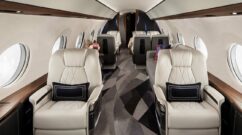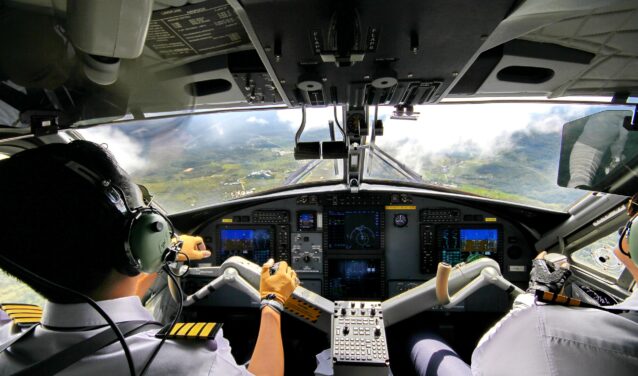
Do you aspire to become an airline pilot, or are you wondering about the different routes to this exciting profession?
Whether you’re a future student in search of your bearings, or simply curious about the world of aviation, this is the resource for you.
Our team of private aviation and air transport professionals will guide you through the different career paths available.
You’ll discover a clear, comparative analysis of the best aviation schools in France, as well as practical advice to help you find your way serenely in this demanding adventure, but accessible to those who prepare rigorously.
The pilot’s profession: rigor, passion and resilience
Responsible for transporting passengers from point A to point B, pilots are what we call cabin crew. His missions are cross-functional and follow a long and complex path: they take place before, during and even after the flight.
1. Before the flight
Before each flight, a briefing is held to familiarize the crew with the technical aspects of the aircraft: radio, communications, geolocation, navigation instruments, etc. A very precise checklist must be checked, and these tasks are divided between the pilots. In general, one pilot is in charge of the “pre-flight inspection”, i.e. the external appearance of the aircraft. The other pilot goes directly inside the aircraft to configure it and prepare the flight plan. This phase of preparation is essential and must be carefully carried out, particularly when calculating the required amount of fuel and studying the weather conditions.
2. During the flight
As sole master of the aircraft, the pilot needs to be discerning, responsive and cool-headed in order to deal with any unforeseen circumstances. That’s why, in addition to a strong sense of responsibility and analytical skills, flight crews need to be in excellent health, with good physical and nervous stamina. In this respect, whether or not they have a medical certificate raises many questions. A class 1 PNT check-up at an aeronautical medical center will be required. During this medical check-up, several elements will be examined:
- sight ;
- hearing ;
- the presence of neurological problems;
- the presence of heart problems..
In the cockpit, the pilot acts on several levels: he controls all the parameters, monitors the on-board computers, and remains in constant contact with air traffic control. Increasingly automated, piloting remains a complex discipline, requiring a certain know-how and a good knowledge of navigation systems. As the person in charge of the flight crew and passengers, the aircraft pilot needs to add two extra strings to his or her bow: a sense of anticipation and an impeccable command of English.
3. After the flight
The pilot’s mission comes to an end a few hours after landing. He must report on the flight, i.e. communicate and pass on his remarks.
These may concern aircraft maintenance: the aim being to improve air safety and anticipate any incidents on future flights.
A pilot’s career path
A pilot’s career offers many possibilities and opportunities for advancement.
Generally speaking, you start out as an airline pilot officer on short- and medium-haul flights, then on long-haul routes.
After around ten years’ experience, you become a Captain on short- and medium-haul flights, and finally a Captain on long-haul flights.
Achieving the position of Instructor Flight Captain on a particular aircraft type represents the pinnacle of a pilot’s career.
Before reaching this stage, a number of training courses and qualifications are obviously necessary.
Here, we explain what goes into becoming an airline and private pilot..
Aeronautical training: how to become a pilot?
Becoming a pilot requires a long apprenticeship and solid ground training.
Whether you take the “royal” state route of the Grandes Ecoles or parallel courses (paid qualifications, the army), learning to fly is a long-term process.
Studies are particularly selective, with around thirty candidates taken at ENAC (École nationale d’aviation civile) each year.
A number of state-approved courses are available at different levels:
- Postbac
- Bac+2 of a scientific curriculum
- PPL (Private Pilot’s License), CPL (Commercial Pilot’s License) and theoretical ATPL (Airline Transport Pilot’s License)
The various diplomas awarded on completion of these studies are numerous, and represent an investment of time and money. That’s why it’s important to choose the right course of study for your goals and chances of success.
After completing these courses, the gross monthly salary for a beginner is around €2,000. This amount varies, however, depending on the airline, the type of aircraft, the distances flown…
A representative sample of 6 French aviation schools: the comparative report
Here is our comparative report on the 6 best aviation schools in France, based on the following criteria:
- ranking among the best engineering schools in France ;
- range of theoretical training courses (bachelors/masters) in aviation and aeronautics offered ;
- practical flight training programs taught
- facilities and equipment available ;
- cost per year of study ;
- duration of training.
1. ISAE-Supaéro
- rank: 4
- number of programs: 14
- pilot program: graduate diploma in aeronautical engineering
- facilities: fleet of nine aircraft, autonomous system platform for microdrones and robots, flight simulators and neuroergonomics platform, wind tunnels, aeroacoustic wind tunnel, turbofan test bench, software-controlled radio room, ground station for satellite tracking and operations, satellite command and control center
- cost per year of study (French student): €4,800
- duration of training: 24 months full-time
2. ESTACA
- rank: 8
- number of programs: 8
- pilot program: aeronautical engineer (master) and airline pilot training
- facilities: simulators, research laboratories, wind tunnels
- cost per year of study (French student): €7,990
- duration of training: 12 months full-time
3. École Centrale de Nantes
- rank: 15
- number of programs: 2
- pilot program: N/A
- facilities: wind tunnels, dynamic and static test center, rapid production platform
- cost per year of study (French student): €2,500
- duration of training: 36 months full-time
4. Institut Polytechnique des Sciences Avancées(IPSA)
- rank: 36
- number of programs: 2
- pilot program: aerospace engineer (master)
- facilities: wind tunnels, research laboratories, intelligent computers
- cost per year of study (French student): €5,500
- duration of training: 36 months full-time
5. École Nationale Supérieure de Mécanique et d’Aérotechnique (ISAE – ENSMA)
- ranking: 53
- number of programs: 2
- pilot program: aeronautical mechanics and energetics (master’s degree)
- facilities: research laboratories
- cost per year of study (French student): €7,300
- duration of training: 24 months full-time
6. ENAC
- rank: 65
- number of programs: 12
- pilot program: airline transport pilot diploma (only for graduates or preparatory students)
- facilities: fleet of 121 aircraft, dedicated flight simulators, advanced air traffic control simulators, aerodynamic, electronic, IT and linguistic infrastructures, four research laboratories
- cost per year of study (French student): €1,300
- duration of training: 36 months full-time
And whatever the chosen course of study, the professional pilot remains above all a man or woman of passion.
Our aviation experts are at your service 24/7 for your private flight at +33 (0) 1 44 09 91 82. Don’t hesitate to visit our online quote to get a price estimate for your private flight.






